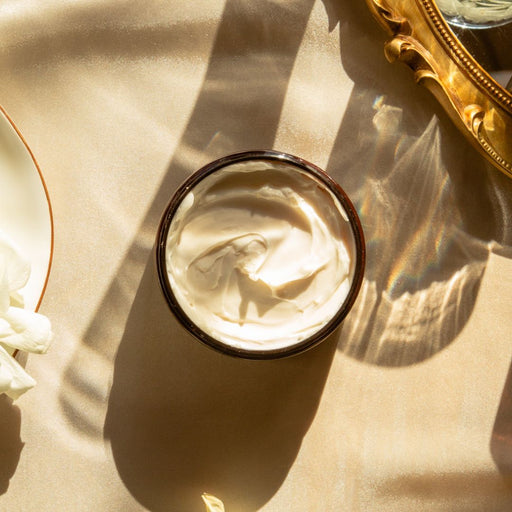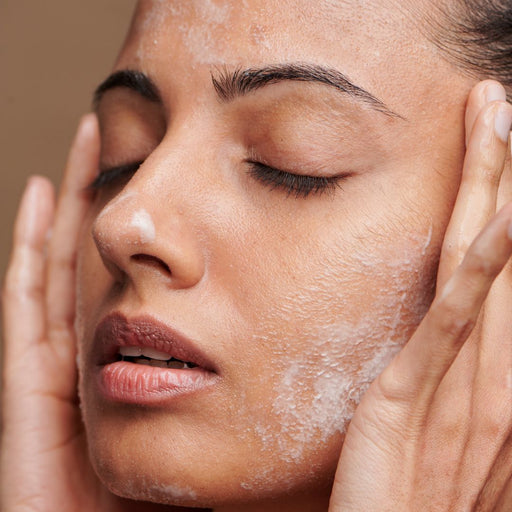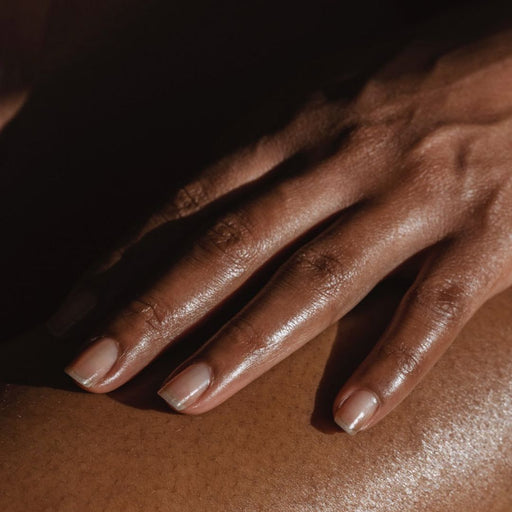Do you have frequent breakouts, rough texture, or uneven skin tone? If so, it sounds like you're in dire need of an exfoliating facial scrub.
Exfoliation can leave skin looking healthier, brighter, and smoother. However, if done improperly, this process can damage your skin barrier. It's important to correctly exfoliate your face based on your skin type so that you can look and feel your best!
At a Glance
-
Normal or Combination Skin: You can exfoliate once or twice a week with either a physical or chemical exfoliator.
-
Dry Skin: Facial exfoliation can help shed dead skin cells.
-
Oily or Acne-Prone Skin: You can safely exfoliate two or three times a week with a chemical exfoliant.
-
Sensitive Skin: Proceed with caution, and exfoliate your facial skin with a natural, soothing product once a week at the most.
Keep reading to learn how to properly exfoliate based on your skin type.
See Related: The 8 Benefits Of Taking A Cold Shower
What Is Exfoliating?
Exfoliation is a skincare technique that removes dead skin cells and other impurities from the skin's surface layer. It can be as simple as cleansing your face with a damp washcloth or applying chemical peels to dissolve the outer layer of skin.
Though some visit a dermatologist or aesthetician for a more intensive exfoliating treatment, you can get excellent results with pre-made facial scrubs.
For an easy DIY body scrub, simply mix 1/2 cup of coconut oil, 1/4 cup of cane sugar, and two tablespoons of your favorite essential oil for a luxurious homemade sugar scrub. Viola!
Bonus: The Best Bedtime Skincare Routine
The Benefits of Exfoliating
Exfoliating makes your skin smoother and softer. It reduces the buildup of dead skin cells, bacteria, and dirt and helps prevent acne by clearing out your pores. It even preps your skin for the rest of your skincare routine.
The benefits of gentle exfoliation also include:
- Brighter complexion
- Dissolves dead skin cells
- Reduced acne scars, dark spots, fine lines, and wrinkles
- Improved blood circulation
- Increased skin cell turnover
- Increased collagen production
- Stronger protective skin barrier
What Are the Different Types of Exfoliation?
There are different exfoliation methods available. If you want to properly polish your skin, you need to understand the ins and outs of each so you can pick the path that's right for you.
Physical Exfoliating
Also known as mechanical exfoliation, physical exfoliation utilizes friction to dislodge, lift, and remove dead cells from the skin's surface. Many physical exfoliation tools, like washcloths or brushes, feature abrasive surfaces.
Face scrubs or body polishes often contain particles like sugar, ground nut shells, or jojoba beads to exfoliate the skin.
Chemical Exfoliating
Chemical exfoliation techniques use stimulating ingredients to encourage skin cell turnover without abrasive scrubbing.
Most chemical exfoliates can be classified as either alpha hydroxy acids or beta hydroxy acids.
-
Alpha hydroxy acids (AHAs): AHAs help break the bonds that hold dull skin cells to the skin's surface, allowing your body to naturally shed dead cells. Examples of AHAs include glycolic acid, lactic acid, and citric acid.
-
Beta hydroxy acids (BHAs): BHAs penetrate more deeply than AHAs to remove dead skin cells and sebum. The most common BHA is salicylic acid.
Best Way to Exfoliate Your Face by Skin Type
Exfoliating requires a personalized approach. Everyone has a unique set of skincare challenges, and it's important to take yours into consideration when exfoliating. If you over-exfoliate or exfoliate incorrectly, you risk exacerbating any existing conditions and compromising your skin barrier.
Additionally, you'll need to avoid exfoliating if you have sunburns, cuts, or severe acne. Your skin needs time to heal before you start exfoliating.
Understanding your skin type is the first step of this process. You might already be familiar with your own, but if you aren't, a quick quiz can give you the insight you need.
So, without further ado, let's get started!
#1. Normal or Combination Skin
It can be hard to identify combination skin. This dual skin type is characterized by an oily T-zone and dry patches on the cheeks. If you notice the presence of both oiliness and dryness, you might have combination skin.
The approach to exfoliating for combination skin is similar to that for normal skin. Normal skin is generally clear and not sensitive.
If you have combination or normal skin, you can exfoliate once or twice a week. It's also a good idea to change up your exfoliating method based on the season.
In the summer, the heat and humidity might make you more prone to excess oil. That's when you can safely use an AHA or BHA chemical exfoliant. In the winter, it's likely your skin will hold dead skin cells, which would call for a physical exfoliant.
#2. Dry Skin
If you have dry skin, you likely have flaky patches and dull areas. Your skin requires a bit more moisture to maintain a natural glow. You've probably noticed your skin becomes drier in the winter or colder months.
A physical exfoliant is best for dry skin, as it can help improve texture and reduce roughness without causing irritation or inflammation. A gentle scrub can help buff dull, dry skin cells from the surface in order to promote a radiant complexion. Exfoliate your skin once or twice a week with a gentle formula that won't be too harsh on your skin.
If you struggle with dullness and lackluster tone, you should try our Radiance Enzyme Scrub. Designed for all skin types, this enzyme mask and enzyme scrub duo also functions as a daily cleanser.
This holy grail product contains natural botanicals like apple enzymes, clove flower, and green tea extract that strengthen and smooth skin. It's also made with jojoba and bamboo beads that gently polish and purify the skin without causing micro-tears on the surface.
But don't just take our word for it - 99% of users felt that their skin was better prepped for the absorption of other skincare products after just one use.
Be sure to apply moisturizer after cleansing to rehydrate your skin. If you're trying to mattify an oily sheen, use our Sweet Black Tea and Ginger Oil-Free Moisturizer.
#3. Oily Skin or Acne-Prone Skin
If you have oily skin, you can take your exfoliating frequency up a notch. Feel free to exfoliate two to three times a week with chemical exfoliators like salicylic acid or glycolic acid. Salicylic acid is a particularly excellent choice for oily skin as it helps clear excess oil that might lead to clogged pores.
When it comes to oily skin, you can use either physical or chemical exfoliants like glycolic acid. If you prefer to use a skin-smoothing scrub, go ahead! Manual exfoliation can help remove the excess oil on your skin's surface.
#4. Sensitive Skin
Those with sensitive skin can often get away with not exfoliating at all. Because dry or sensitive skin is more prone to irritation and redness, many types of exfoliation can be too harsh on this delicate barrier.
If you're ready to start exfoliating your skin, always start slow and see how your skin reacts. Your skin might be able to tolerate exfoliating once a week, or maybe it will only be able to handle it once a month.
It's a good idea to steer clear of drying chemicals and harsh brushes. Gentle scrubs or hydrating AHAs like lactic acid might be your best bet.
Final Thoughts
If you're new to exfoliating your skin, be sure to do your research before adding scrubs or exfoliating acids to your skincare routine. Experiment with different tactics to find what is best for your skin, and avoid over-exfoliating at all costs. Treat your body with care, and it will show you love right back!
Keep Reading: How to Build a Morning Skin Care Routine For Glowing Skin
--
Juara Skincare incorporates ancient rituals with Western skincare science, creating the ultimate beauty experience. We aim to transport you from the mundane to the extraordinary with our exotic ingredients, intoxicating scents, and powerful, skin-improving formulas. All of our products are nutrient-rich and botanically based. We are proud to be certified cruelty-free. Get the latest skin care tips and info on Juara products by following us on Twitter, Facebook, Instagram, LinkedIn, and Pinterest.













